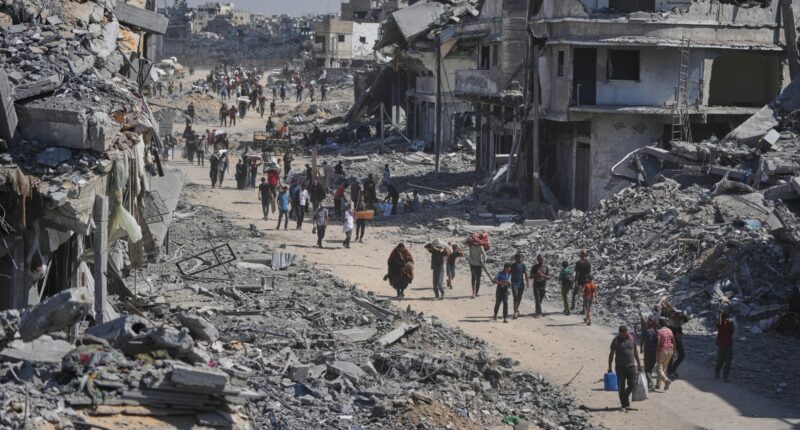Share this @internewscast.com
WASHINGTON — On Sunday, President Donald Trump will journey to Israel and Egypt to commemorate the U.S.-facilitated ceasefire and hostage agreement between Israel and Hamas. His visit aims to encourage Middle Eastern allies to capitalize on this moment to establish a lasting peace in the often tumultuous region.
This juncture is precarious as Israel and Hamas are just beginning to implement the initial segment of the Trump-negotiated agreement, intended to permanently conclude the conflict ignited by the Oct. 7, 2023 assault on Israel by Hamas-associated fighters.
Trump thinks there is a narrow window to reshape the Mideast and reset long-fraught relations between Israel and its Arab neighbors.
According to the Republican president, this situation has been facilitated by his administration’s endorsement of Israel’s decisive actions against Iranian-backed groups, including Hamas in Gaza and Hezbollah in Lebanon.
The White House reports that there is growing momentum because Arab and Muslim countries are increasingly prioritizing the resolution of the long-standing Israeli-Palestinian conflict and, in some instances, strengthening their ties with the United States.
“I believe you’re going to see immense progress and Gaza will undergo reconstruction,” President Trump stated on Friday. “There are several affluent nations in that region, and it would require only a small portion of their wealth to rebuild. And I think they are willing to do it.”
A tenuous point in the agreement
The preliminary phase of the ceasefire deal includes the release of the final 48 hostages held by Hamas, with about 20 still thought to be alive, the liberation of numerous Palestinian prisoners held by Israel, an increase in humanitarian support to Gaza, and a limited withdrawal of Israeli troops from Gaza’s primary urban areas.
Israeli troops on Friday finished withdrawing from parts of Gaza, triggering a 72-hour countdown under the deal for Hamas to release the Israeli hostages, potentially while Trump is on the ground there. He said he expected their return to be completed on Monday or Tuesday.
Trump said he will first visit Israel, where he has been invited to address Israel’s parliament, the Knesset, an honor last extended to President George W. Bush during a visit in 2008. Trump then will travel to Egypt, where he and Egyptian President Abdel-Fattah el-Sissi will lead a summit in Sharm el-Sheikh with leaders from more than 20 countries to discuss peace in Gaza and the broader Middle East.
It is a tenuous truce and it is unclear whether the sides have reached any agreement on Gaza’s postwar governance, the territory’s reconstruction and Israel’s demand that Hamas disarm. Negotiations over those issues could break down, and Israel has hinted it may resume military operations if its demands are not met.
“I think the chances of (Hamas) disarming themselves, you know, are pretty close to zero,” H.R. McMaster, a national security adviser during Trump’s first term, said at an event hosted by the Foundation for the Defense of Democracies on Thursday. He said he thought what probably would happen in the coming months is that the Israeli military “is going to have to destroy them.”
Israel continues to rule over millions of Palestinians without basic rights as settlements expand rapidly across the occupied West Bank. Despite growing international recognition, Palestinian statehood appears exceedingly remote because of Israel’s opposition and actions on the ground,
The war has left Israel isolated internationally and facing allegations of genocide, which it denies. International arrest warrants against Israeli Prime Minister Benjamin Netanyahu and his former defense minister are in effect, and the United Nations’ highest court is considering allegations of genocide brought by South Africa.
Hamas has been militarily decimated and has given up its only bargaining chip with Israel by releasing the hostages. But the Islamic militant group is still intact and could eventually rebuild if there’s an extended period of calm.
Netanyahu reiterated that Israel would continue with its demilitarization of Hamas after the hostages are returned.
“Hamas agreed to the deal only when it felt that the sword was on its neck – and it is still on its neck,” Netanyahu said Friday as Israel began to pull back its troops.
Trump wants to expand the Abraham Accords
Much of Gaza has been reduced to rubble and rebuilding is expected to take years. The territory’s roughly 2 million residents continue to struggle in desperate conditions.
Under the deal, Israel agreed to reopen five border crossings, which will help ease the flow of food and other supplies into Gaza, parts of which are experiencing famine.
Trump is also standing up a U.S.-led civil-military coordination center in Israel to help facilitate the flow of humanitarian aid as well as logistical and security assistance into Gaza.
Roughly 200 U.S. troops will be sent to help support and monitor the ceasefire deal as part of a team that includes partner nations, nongovernmental organizations and private-sector players.
The White House has signaled that Trump is looking to quickly return attention to building on a first-term effort known as the Abraham Accords, which forged diplomatic and commercial ties between Israel and the United Arab Emirates, Bahrain and Morocco.
A permanent agreement in Gaza would help pave the path for Trump to begin talks with Saudi Arabia as well Indonesia, the most populous Muslim country, toward normalizing ties with Israel, according to a senior Trump administration official who briefed reporters on the condition of anonymity.
Such a deal with Saudi Arabia, the most powerful and wealthy Arab state, has the potential to reshape the region and boost Israel’s standing in historic ways.
But brokering such an agreement remains a heavy lift as the kingdom has said it won’t officially recognize Israel before a resolution to the Israeli-Palestinian conflict.
—
Krauss reported from Ottawa, Ontario.
.

















